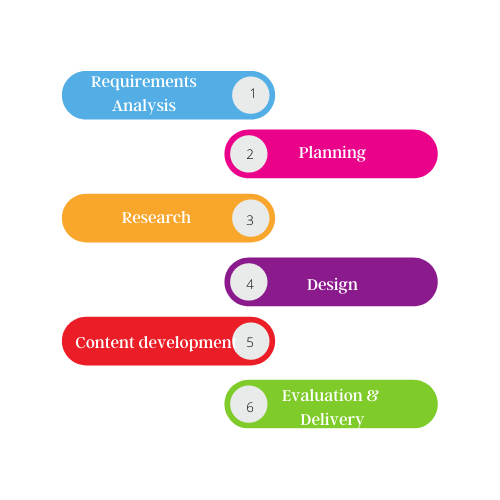e-Learning! When we hear this word the first thought that comes to most of our minds is ‘the perfect blend of technology and learning.’ On the other hand, this technology has evolved so much in such a short time that e-Learning developers could find it hard to keep up with the pace and get acquainted with the latest developments. To solve this problem, we have created a simple and effective workflow that you can use to create your e-Learning courses.
Ground Rules to Remember While Create eLearning Courses
To make this setup process easier, there are a few ground rules that we must establish and follow. The basic ground rules are:
- Learner is not in the pillion. Learner is the driver for your course.
- Your content is the backbone of your course, so make no compromises here.
- Engagement and right tone in writing the content is as important as your content.
- Too much of anything is good for nothing! So, keep your content at the right amount.
- Assessment is not just a tool to evaluate your learners, it can act as a learning tool too, use it right!
This list is ‘not for compromise!’ If you are looking at developing a decent e-Learning course, let alone a great one, you need these rules to stay.
Every skyscraper we see started out with a strong foundation; your course is no exception. To build a great course, you need to get to the ground and work on understanding the basics right. Requirements are the foundation of building a great course.

Stages of e-Learning workflow setup
Step #1: Requirements Analysis
Understanding the requirements of the course is the foundation. We all know how important foundation is for a building. If we don’t get this right, the result isn’t going to be acceptable. So, the majority of the time spent in the development phase should go into the requirements analysis.
The ideal way to begin the requirements analysis is by sitting for a chat with the client. When you do so, you get to know the background of the client, understand why they are building this course, and what the expected outcomes are. Further, this is a great opportunity to learn about the consumers of the course.
To make this process seamless, create a questionnaire that can capture all critical information on the course for you. To make this process easier, we have created a Course requirement analysis questionnaire.

Time you should spend on each phase of course development
Step #2: Planning
Now that you have captured all critical information, your groundwork is almost done. The final touch here is to plan out how you would develop the course from the requirements you captured. I am sure we have all come across the phrase, “Visualisation is a powerful tool!” So, let’s use it here!
Visualise your product and this is an extremely powerful way to create your plans. Develop a detailed plan on how you would develop this course. Create specific milestones and a reasonable deadline for each milestone. Clearly layout specific deliverables for each milestone and ensure you provide enough time to complete it.
Remember, compromising on quality to meet the deadline is not an option. Discuss the timeline for development with the client after you create a plan and not before!
Step #3: Research
Research is an extremely important part of any development. e-Learning courses can be delivered to a diverse group of audience and their expertise can vary too. So, the content developed for a course must be well-researched and written exceptionally well.
In this stage of development, focus on gathering research materials related to the course. Let’s admit it! We are not here to create new content that was never said! We are here to develop e-Learning course content that will help learners understand concepts and reach specific learning objectives. To do this, it is critical that we find all relevant content and frame it right to be easily consumable for the target audience.
Maintaining a repository of good resources can be an asset for e-Learning developers. After all, information is wealth!
Step #4: Design
It is now time to begin your template designing. Every course must have a specific template. Base your template design on the client’s brand and the course topic. Creating a relevant template makes the learner’s journey easier.
When designing templates, create presentation template, worksheet template, handout template, video template, flyer template, and ad template. It is important to keep your marketing material and the course design in sync as it can help the learner set their expectation right.
Step #5: Content Development
Now, begin thinking about the structure of the course. The best way to do this is list all topics you would like to discuss and then begin grouping the topics to form lessons, and then group lessons to form modules. This is practically reverse engineering process to create a structure for your course.
Once you decide on the number of modules, lessons, assessments your course will contain, create a detailed course map with the entire course structure. Mind maps usually help this cause better and create a visual representation of your course that can be easily consumed.
The next step would be to create course objectives, module learning outcomes, and the lesson goals. After the structure and the overall goals are established, begin writing each lesson in detail. Decide on the tone you will use in the course and write the content. Ensure you divide each lesson into subtopics and link it to the overall lesson and module goals and objectives.
Carefully plan and create the right assessments for your course.
Pro tip: Give your content a personal touch and style and it will help learners connect with the course better.
Step #6: Evaluation and Delivery
Once the content development is complete, you are almost at the end line. The last step is stitching it all together. You have now built several independent pieces of information; it is time to put it all together and ensure it takes a sensible format. Adding voice over narration or recording the course in front of the camera is done in this stage.
Once this is done, you are ready to go through the entire course and make necessary changes. You must take the time to experience the course you have designed and make corrections where required. Even an experienced e-Learning developer will miss little details in the course, and this is where you proofread and edit your course. Do it patiently and you will save a lot of time later!
After you test your course, you are ready for delivery!
Deliver it on time and get ready to enjoy the smile on your client’s face!
If you are designing learning pathways for employee training these steps can be helpful.
Good luck!
Suggested Readings
Designing Learning Paths for Employee Training & Development
Table of content 1. Introduction 2. Learning is learner-centric 3. A 5 Step Process “Known is a drop and unknown are an ocean” is a famous saying. This simply means we never stop learning through our life. Learning is a continuous process regardless of where we...
SBL technique (Scenario Based Learning) in eLearning
Scenario-Based Learning (SBL) is a common learning technique used in online education. In this post, we will look at a few examples of how you can use Scenario Based Learning to enhance both formal and informal learning. Scenario-Based Learning (SBL) - What Is It? ...
Introduction to instructional designing — The fundamental guide
Table of Content: 1. How is Instructional Design defined? 2. What Are Instructional Designers' Responsibilities? 3. Some critical areas that an Instructional Designer should focus on How Is Instructional Design Defined? Fundamentally, consider Instructional Designing...
Various eLearning assessment strategies
In the digital age, student assessment has evolved along with every other development. While there is something to be said for the old classroom-based approaches, scientists are constantly developing advanced inventions to help teachers with evaluating students...
Top 7 reasons why you should develop and deploy learning nuggets (bite-sized learning) in eLearning
Table of Content: 1. Introduction 2. Bite-sized learning enhances mental and emotional involvement 3. Bite-sized modules make use of the natural ebb and flow of our energy 4. Content in bite-sized portions pushes the boundaries of our working memory 5. Smaller chunks...
Importance of assessment in eLearning
An essential aspect of the eLearning classroom is assessment. It gives learners an indication of how far they've progressed in a curriculum, recognizes personal capabilities and limitations, and, in the end, determines if they've not met the course's educational...
Learning interventions to use in your eLearning
Table of Contents Introduction Factors to consider while deciding mode of delivery Types of course modules Categories of learning interventions Best learning interventions to useLearning is a continuous process! We all begin learning from the moment we are born and...
Designing learner centric eLearning- The complete guide
Table of Content: 1. Introduction 2. Self-exploration guide 3. Do not try to reinvent the wheel 4. Rethink your learning objectives 5. Providing freedom of choice 6. Providing room for expansion An eLearning course is built to meet the needs of numerous stakeholders...
How to hire an eLearning developer?
Table of Content: 1. Practical experience matters 2. Understanding of basic education 3. Creativity 4. Communication 5. Knowledge about user interface designing eLearning is slowly evolving to be the bedrock of learning and development in many organizations across...
How is eLearning beneficial for an organization
Table of Content: 1. Minimum Learning Unit (MLU) 2. Freedom for employees 3. Cost effective 4. Easy to track 5. Scalable and fast 6. Customizable 7. Virtual training for virtual world Today in the hyper-connected world we live in, learning is everywhere. It has...
















